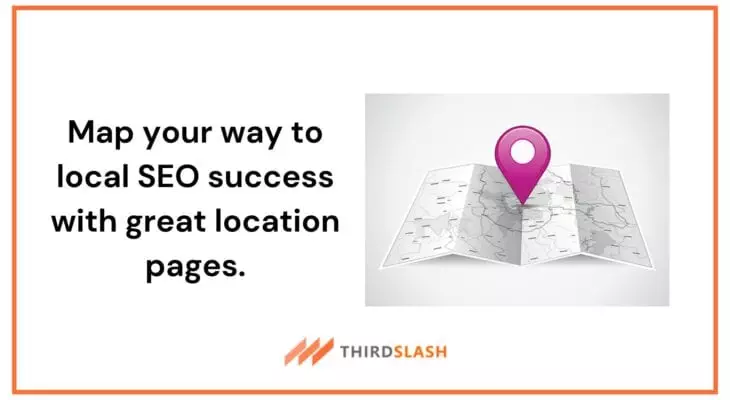Single Blog

How to Effectively Create Location Pages for Local SEO Success?
- admin
- February 10, 2025
- 0 Comments
Businesses functioning in today’s digital ecosystem must concentrate on Local SEO tactics to appeal to their nearby consumer base. Location pages emerge as one of the strongest tools for enhancing local search visibility when properly optimized. Company pages enable businesses to achieve better search results for targeted location-related queries which reduces the difficulty for prospective customers to discover them on the internet. All businesses with one or multiple physical locations should develop specific location pages because these pages fundamentally enhance your location rankings which ultimately leads to increased customer traffic in local markets.
An optimized location page helps rankings while delivering useful content to users which includes business details together with operating times and service descriptions and client feedback. Specific location page optimization failures from businesses cause both below-par search positions along with lost client possibilities. A step-by-step process will help you build SEO-friendly location pages that generate improved outcomes.
Why Are Location Pages Important for Local SEO?
The search engine Google depicts its results to users according to relevance criteria. Google shows local businesses which best match user search queries and stands closest to the search location while being prominent in its category. Optimized location pages help businesses appear in:
- Google’s Local Pack (the top 3 map results)
- Organic search engine results systematically present businesses that match local search criteria
- Google Maps searches
Businesses that optimize their pages with local keywords and add structured data and user-friendly content improve their local online visibility to draw in more service-seeking customers.
Essential Elements of a High-Performing Location Page
1. Optimize for Local Keywords
Targeting the right local keywords stands as the key to establishing a successful location page. Your content should include local keywords which viewers in your market seek when conducting online searches. For example, if you own a bakery in New York, your page should target terms like:
- Best bakery in New York
- Fresh pastries near me
- Artisan bread in NYC
The tools Google Keyword Planner and Ahrefs assist you in discovering local search terms you should integrate naturally into your content.
2. Include NAP Information
NAP stands for Name, Address, and Phone Number. Ensuring that this information is consistent across your website, Google Business Profile (GBP), and online directories is crucial for Local SEO. Search engines use NAP details to verify business legitimacy and determine rankings.
Make sure to:
- Display NAP details prominently on the page.
- Use schema markup to help search engines understand your business location.
3. Create Unique Content for Each Location Page
Several organizations make the error of simply sharing text between various location web pages. Each page on a website should contain exclusive information because Google detects duplicated material and delivers penalties against it. Instead of using a generic template, customize the content by:
- Highlighting location-specific services
- Showcasing testimonials from local customers
- New blog content adds value through regional posts
Your business fitness center should highlight unique features at each location including special amenities, trainers and events available specifically per facility.
Enhancing User Experience and Engagement
4. Use High-Quality Images and Videos
A location page becomes more interesting with pictures of exterior store views as well as pictures of the interior and your staff members alongside item photographs. A customer becomes more likely to visit one business over another when they successfully understand what a location looks like.
Customer testimonials in addition to virtual storefront tours alongside behind-the-scenes videos will boost visitor engagement at this page thus causing extended viewing periods that strengthen ranking potential.
5. Embed Google Maps for Easy Navigation
Your site users can quickly identify your business location using the embedded Google Maps on your location page. Your Google Maps embed communicates to Google that your business matters in local search results.
Ensure your map features interaction and precise pinpointing of your business location which enables users to generate route directions.
6. Encourage Customer Reviews
Customer reviews are essential for building trust and improving local rankings. Encourage satisfied customers to leave reviews on:
- Your Google Business Profile
- Your website’s location page
- Third-party review platforms like Yelp
Positive reviews not only enhance credibility but also improve your chances of ranking higher in local search results.
Technical SEO for Location Pages
7. Implement Local Schema Markup
Structured data known as schema markup serves search engines by enhancing their understanding of business information. Use LocalBusiness schema to provide Google with details like:
- Business name
- Address
- Phone number
- Operating hours
- Customer reviews
The Structured Data Markup Helper from Google serves as a tool to create this markup.
8. Improve Page Speed and Mobile Optimization
Mobile users conduct the vast majority of local searches so your location pages need to function perfectly on all mobile platforms. To maintain the best possible user experience implement responsive design while minimizing image file size to accelerate website loading times.
Page Speed Insights from Google helps business owners find ways to enhance their operations.
Leveraging Location Pages for Better Conversions
9. Add a Clear Call-to-Action (CTA)
A well-optimized location page should guide visitors toward taking action. Use clear and compelling CTAs such as:
- Call Now for a Free Consultation
- Book an Appointment
- Visit Us Today
Ensure these CTAs are visible and strategically placed throughout the page to encourage conversions.
10. Link to Internal and External Resources
Internal linking to related service pages or blog posts keeps users engaged and improves SEO. Additionally, linking to external resources like your Google Business Profile or social media pages can strengthen credibility.
